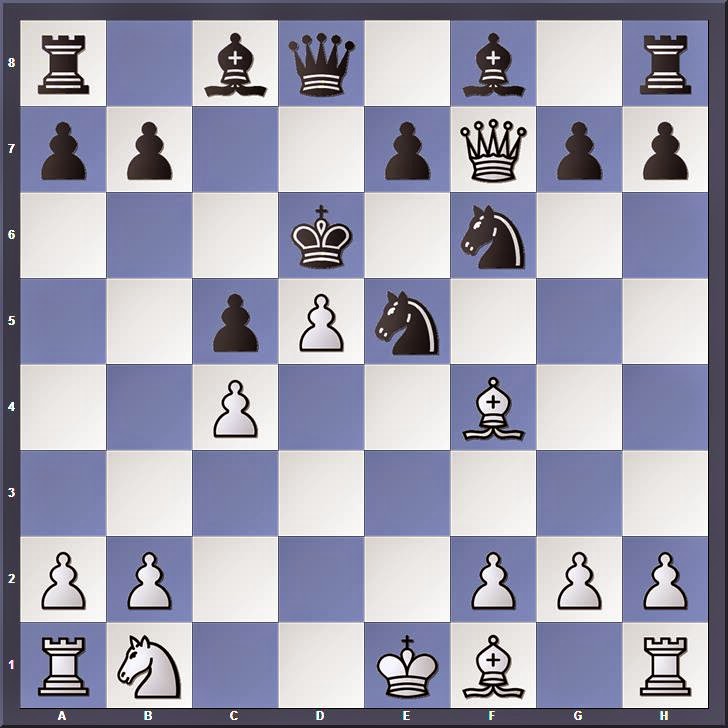This was a betrayal of myself.There is a line of the Alekhine Defense in which the Black king strolls towards the center after White's knight sacrifice. The line resembles the Fried Liver Attack, but is more often played by Grandmasters.
Mikhail Tal
In one game, Bent Larsen defended the Black side well and won a nice miniature against Mikahil Tal. In another game, Tal worked out the variations all the way to checkmate before sacrificing the knight. The Black king was driven to a1 where it was checkmated with White's few remaining pieces.
These games are fantasy variations that stem from a war of nerves in which Larsen scored an important victory against the master of attack, but still lost the Candidate's Match against the former World Champion. Tal spent fifty minutes contemplating the knight sacrifice, trusted his opponent's preparation, and opted for a safer route. He ended up in a worse position, but managed to salvage a draw in the endgame.
My interest in this line was provoked by Yasser Seirawan's excellent recent lecture at the Chess Club of Saint Louis, "A History of Chess Openings". Near the end of the lecture, Seirawan indicates that he may have mixed up the moves of Tal -- Larsen, but goes on to make some astute comments concerning opening preparation. He had spent several days been looking at "the conservative and the super sharp lines" of this opening. Tal's trapped queen and another quieter game he showed first illustrate the possible varieties. Seirawan predicts that the Alekhine Defense, like the early queen exchange in the Berlin Defense, could become a new hot trend in Grandmaster play.
Here is the game that Seirawan remembered.
Tal,Mikhail -- Larsen,Bent [B04]
Candidates Semi-Final Bled (4), 1965
1.e4 Nf6 2.e5 Nd5 3.d4 d6 4.Nf3 dxe5 5.Nxe5 Nd7
Larsen offered Tal an opportunity to drive his king to the center with a knight sacrifice.
6.Nxf7 Kxf7 7.Qh5+ Ke6 8.c4 N5f6 9.d5+ Kd6 10.Qf7 Ne5 11.Bf4 c5
White to move
12.Nc3
12.b4 is the main line in my edition of Encyclopedia of Chess Openings.
12...a6 13.0–0–0
See the next game for 13.Rd1
13...g5 14.Bg3 Bh6 15.Re1
Seirawan does not offer 15.d6, which has been played in similar positions (after 13...g6 and no 14.Bg3).
15...g4+ 16.Kb1 Bf5+ 17.Ka1 Rf8 18.Bxe5+ Kd7
White to move
Unable to rescue his queen, it is time for White to resign.
0–1
In Attack with Mikhail Tal, trans. Ken Neat (1994), Tal explains his thinking after Larsen's shocking 5...Nd7.
My intuition insistently kept telling me that the sacrifice had to be correct, but I decided to calculate everything "as far as mate", spent some 50 minutes, but then in one of the innumerable variations I found something resembling a defense, and ... rejected the sacrifice. This was a betrayal of myself, I saved the game only by a miracle after the adjournment.
Here is the variation that Tal presents in the opening section of his book.
Tal,Mikhail -- Larsen,Bent [B04]
Candidates Semi-Final Bled (4), 1965
1.e4 Nf6 2.e5 Nd5 3.d4 d6 4.Nf3 dxe5 5.Nxe5 Nd7 6.Nxf7 Kxf7 7.Qh5+ Ke6 8.c4 N5f6 9.d5+ Kd6 10.Qf7 Ne5 11.Bf4 c5 12.Nc3 a6 13.Rd1 g6 14.Bxe5+ Kxe5 15.d6 g5 16.Rd2 Bf5 17.Re2+
Black to move
17...Kd4 18.Re4+ Bxe4 19.Qe6
Black to move
Perhaps the defense that he found in his calculations was 19...Qd7, covering h3 or 19...Qb6, covering b3.
White's threat, according to Tal is 20.Ne2+ Kd3 21.Qh3+ Kc2 22.Qb3+ Kb1 23.Nc3+ Ka1 24.Bd3 Bxd3 25.Kd2+ Bb1 26.Rxb1# 0–1
Here is the game that was actually played.
Tal,Mikhail -- Larsen,Bent [B04]
Candidates Semi-Final Bled (4), 1965
1.e4 Nf6 2.e5 Nd5 3.d4 d6 4.Nf3 dxe5 5.Nxe5 Nd7 6.Bc4
Black to move
6...e6 7.Qg4 h5 8.Qe2 Nxe5 9.dxe5 Bd7 10.0–0 Bc6 11.Rd1 Qe7 12.Nc3 Nxc3 13.bxc3 g6 14.a4 a6 15.Rb1 Qc5 16.Be3 Qxe5 17.f4 Qf5 18.Bd3 Qg4 19.Qf2 Be7 20.Bd4 0–0 21.Be2 Qf5 22.Bd3 Qg4 23.Be2 Qh4 24.g3 Qh3 25.Bf3 Rad8 26.Bxc6 bxc6 27.Be5 Qf5 28.Qe2 Bd6 29.Rd3 Bxe5 30.fxe5 Rxd3 31.cxd3 Rd8 32.Rd1 c5 33.c4 Qg4
White to move
34.Qxg4 hxg4 35.Kf2 Rb8 36.Rd2 Kg7 37.Ke3 g5 38.d4 Rb3+ 39.Kf2 cxd4 40.Rxd4 Kg6 41.Rxg4 Rb2+ 42.Kg1 Kf5 43.Rd4 Kxe5 44.Rd7 f5
White to move
Black must be better here with an active king and a pawn majority on the kingside.
45.Rxc7 Ke4 46.Rd7 Rc2 47.Rd6 e5 48.h4 gxh4 49.gxh4 Rxc4 50.h5 Kf3 51.Rd3+ Kg4 52.h6 Rc7 53.Rd6 e4 54.Kf2 a5 55.Rg6+ Kh5 56.Ra6 f4 57.Re6 Rc2+ 58.Ke1 Rc1+ 59.Kd2 Rh1 60.Rxe4 Kg4 61.Re6 Kg3 62.Rf6 f3 63.Ke3 Re1+ 64.Kd3 Re7 65.Rg6+ Kf4 66.Rf6+ Kg3 67.Rg6+ Kf4 68.Rf6+ Kg4 69.Kd4 Kg3 70.Rg6+ Kh3 71.Rg7
Black to move
71...Rxg7 72.hxg7 f2 73.g8Q f1Q 74.Qe6+ Kh4 75.Kc5 Qb1 76.Qc4+ Kg3 77.Qc3+ Kf2 ½–½
All three games are instructive. This is as true of the game played as of the two unplayed fantasies.




















No comments:
Post a Comment